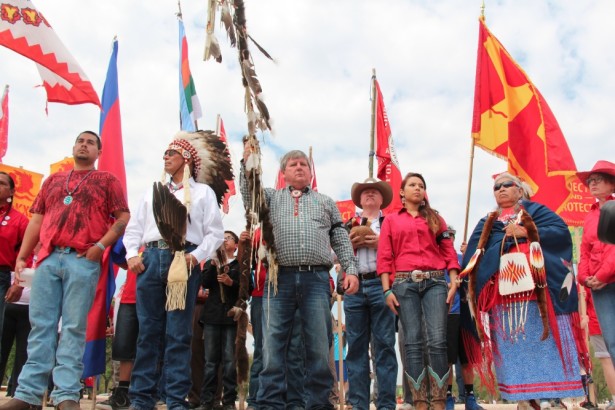The new multi-billion-dollar Midwest Carbon Express pipeline — proposed last fall to carry ethanol refinery waste from Iowa to underground injection sites in North Dakota — has generated a wave of resistance over the threat of eminent domain, or the seizure of land for “public good.” The unlikely alliance of farmers, ranchers, Indigenous tribes, scientists and environmentalists that has arisen has hung banners off of freeway overpasses, rallied in front of the Iowa State Capitol and held meetings in communities all along the proposed route.
This campaign offers yet another example of the potential of working across lines of deep-seated traditional enmity to accomplish shared goals. They hearken back to the Cowboy and Indian alliance campaign against the Keystone XL pipeline in 2013. Native people and ranchers from the deeply red states of Nebraska and South Dakota riding their horses together into Washington, D.C. in full regalia, to set up camp near the White House and send a message as one to President Obama was a striking image of unity. They had come together, somewhat uneasily, to act in the face of a common external threat, but through that process they began to appreciate each other in different ways.
Previous Coverage
 When Cowboys and Indians unite — Inside the unlikely alliance that is remaking the climate movement
When Cowboys and Indians unite — Inside the unlikely alliance that is remaking the climate movementAs this group of ranchers, farmers and tribal communities from along the tar sands pipeline route worked together against its construction, the tribes influenced some white neighbors to protect sacred burial sites on property they now owned. “We come from two cultures that clashed over land,” Alliance spokeswoman Faith Spotted Eagle observed. “This is a healing for the generations.”
What would it look like to take a page from this book, learn from the successes of our populist history and work together on other shared issues across other deep lines of enmity? The divisions in our country are deep, and the distances between us seem to be widening every day — but still what we have in common is greater than what divides us.
Our history warns against the forces that try to make enemies out of those with shared interests. White and Black indentured servants in the colonial era were systematically separated from each other to keep them from rising up together to fight their common economic oppression — and the codification of the laws of slavery was the result. An “other” had been created, even more fearsome to those oppressed white workers than their own terrible living conditions, giving them compelling reasons to abandon that solidarity.
Arguably the most critical issue we face these days is the ever-growing power of the moneyed sector over everybody else. Its tentacles reach everywhere — into housing, wages, debt, health care, the environment — all the issues we care most deeply about. Its linked lobby power and ability to buy elections are a grave threat to democracy. Yet ordinary people on the right and on the left are being systematically taught to see each other as the greatest enemy.
Arlie Hochschild, author of “Strangers in Their Own Land,” speaks to the role of cosmopolitan liberals in this dynamic. She warns against arrogance, asking why liberal commentators feel so free to catcall. Saying that we may be able to see what white rural conservatives can’t see — but not what we can’t see — she challenges us to “scale the empathy wall.”
Imagine waiting patiently in line for the American Dream, which lies just over the hill. It’s a long line that doesn’t seem to be moving any more. Worse, others are cutting in. “Strangers step ahead of you in line, making you anxious, resentful and afraid,” Hochschild writes. “A president allies with the line cutters, making you feel distrustful, betrayed. A person ahead of you in line insults you as an ignorant redneck, making you feel humiliated and mad. Economically, culturally, demographically, politically, you are suddenly a stranger in your own land.” It’s not surprising that such people are attracted to the emotions-based appeal of someone like Donald Trump, thrilled to be welcomed into a powerful movement where they feel respected and seen.
Of course the differences among us are real. Rural white conservatives are loyal to a deeply-flawed free market as a bulwark against predation from a big government and all the “takers.” Cosmopolitan liberals, on the other hand, are loyal to a deeply-flawed federal government as a bulwark against free market predation.
Yet there’s much to be learned from the examples of deeply-red small towns and rural communities taking on powerful moneyed interests and working together toward a vision of respect, meaningful democratic participation and sustainable livelihoods. Such a lesson can be found in the story of Grant Township.
Located in Indiana County in western Pennsylvania, Grant Township is an overwhelmingly rural area. Far from any seat of power, it has just 639 residents. These were all good reasons for the Pennsylvania General Energy Company, or PGE, in 2012, to choose the area as a site for the injection of toxic hydraulic fracking chemicals. Who would know, who would care?
Yet residents of the township got word of the deal and rallied to protect their water by passing a Community Bill of Rights ordinance in 2014. This law addressed rights to local community government and clean air and water, and the rights of local ecosystems — with the proposed injection well as a violation of those rights.
After a federal judge ruled that the township lacked authority to ban injection wells, a super-majority of residents voted for a rights-based home-rule charter, changing the township’s form of government to a more powerful one and overriding the judge’s decision.
In 2016, in an extraordinarily innovative move, they followed up with a law legalizing nonviolent action to stop the injection well. Grant Township Supervisor and Chairman Jon Perry asked, “Should a polluting corporation have the right to inject toxic waste, or should a community have the right to protect itself? I was elected to serve this community, and to protect the rights in our charter voted in by the people I represent. If we have to physically and nonviolently stop the trucks from coming in because the courts fail us, we will do so. And we invite others to stand with us.”
Nevertheless, the state issued a permit to PGE and sued Grant, as did PGE, claiming the charter unlawfully interfered with state oil and gas policies. In March 2020, after more suits and countersuits, Grant Township had an unprecedented win. The state Department of Environmental Protection revoked the frack waste permit, citing the township’s local law that bans such wells and asserts the rights of local ecosystems.
The lawsuits continue, and the folks in Grant Township are weary but unbowed. Retired teacher and community leader Judy Wanchisn reflected, “It’s the hill we decided to die on. We said no. Everything we try, if that doesn’t work, we’ve tried something else, and just keep going. It’s all we can do.”
Stacy Long, one of the leaders of the struggle and another township supervisor, concurred, saying, “I will do whatever it takes to provide our residents with the tools and protections they need to nonviolently resist aggressions like those being proposed by PGE … I think this project will kill people … You had to do something. So I did it.”

Support Us
Waging Nonviolence depends on reader support. Become a sustaining monthly donor today!
DonateHere is an opportunity for environmental and anti-corporate activists to claim this community, one that voted overwhelmingly for Trump, as people we would want to know, whose movement we would want to learn from, and whose victories we would want to celebrate as our own.
There are other inspiring examples we can learn from of staunchly conservative small towns fighting for community rights against staggering odds. Residents of Barnstead, New Hampshire, learned in 2001 that a big corporation, USA Springs, had an eye on their local aquifer as a source of water to sell overseas. Saying their water was not for sale, community members launched into a protracted struggle and made history in 2006, adopting the first-in-the-nation Community Rights law. It stated that corporate water withdrawal for resale was a violation of democratic and environmental rights — and was therefore banned.
A common factor here seems to be the courage and vision to go beyond protest at the regulatory hearing level and be willing to frame the issues around deeper community and environmental rights. Perhaps this is a place, in the face of moneyed predation, where all of us — rural western ranchers and Indigenous people, cosmopolitan coastal liberal and rural conservatives alike — can find common ground.

Pamela: Such a good and hopeful article! Thanks for writing this and for you have done and continue to do, Penn Garvin